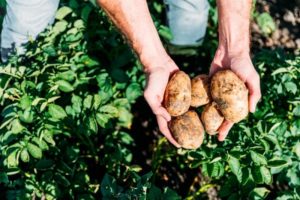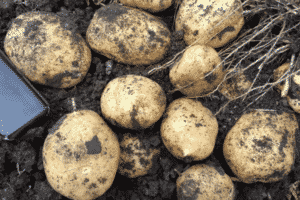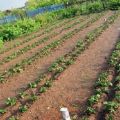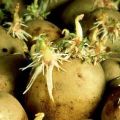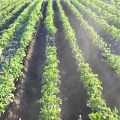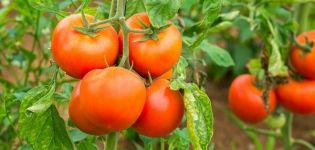What is potato senication and desiccation, how to apply and when to carry out
For increase potato yield on poor-quality soil, senication and desiccation are used. Agrotechnical techniques help to increase the mass of potato tubers and the quality of root crops. Desiccation and senication of potatoes are used both on an industrial scale and in summer cottages.
Potato senication, what is it?
The senication procedure is the processing of tops with chemicals in preparation for harvesting. A double phosphate solution is used as a non-toxic chemical or liquid complex fertilizer... The main reasons for conducting agricultural reception are as follows:
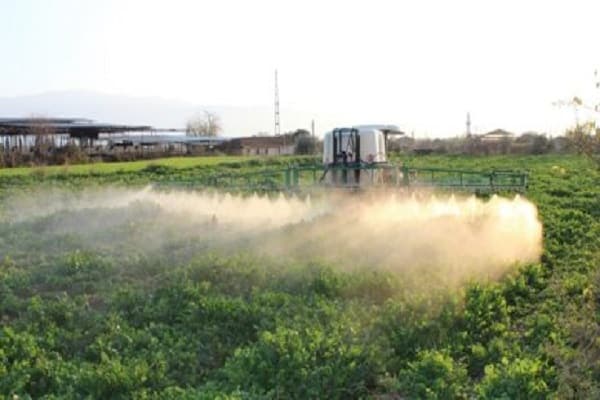
- Spraying plants completely stops the growth of the stems, due to which the outflow of photosynthetic products from the tops to the root crops is activated and they mature more actively.
- The proportion of starch and protein in the composition of tubers increases, and the content of nitrates decreases to a level that is safe for human health.
- By acquiring a denser rind after processing, tubers are less damaged during harvest, and the total yield increases by 15–20%.
- Under the influence of a chemical solution, the risk of contamination of soil and vegetation with late blight and rhizoctonia is reduced.
- The composition of solutions used for senication of a potato crop contains biogenic elements necessary for the correct metabolism of plants.
Senication is very useful if you want to leave the crop for long-term storage. As a result of treatment, the starchiness of the tubers increases and the cork tissue thickens. The harvested crop not only receives useful macro- and microelements, but also acquires an attractive presentation.
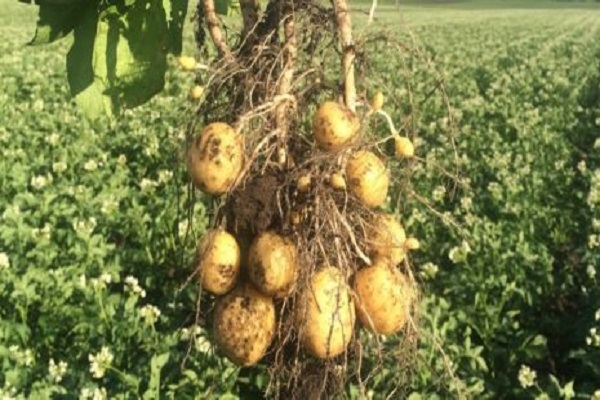
How to conduct a senication?
If it is necessary to quickly process a large industrial site, the aviation method is used. To work in a personal or summer cottage, a sprayer and a chemical protection suit will be enough. When spraying tops with hand-held sprayers, the consumption of the working solution should be 10 liters per 50-60 m of land.
You can start senikation only in the early morning or in the evening in warm, calm weather. The processing of the tops will give the greatest effect 20–25 days before harvest, when a period of mass flowering is observed.
The processing technique is simple - you need to pour the prepared solution into the sprayer and apply it evenly on potato tops... If it rains immediately after the treatment, the procedure should be repeated when the dew dries up.
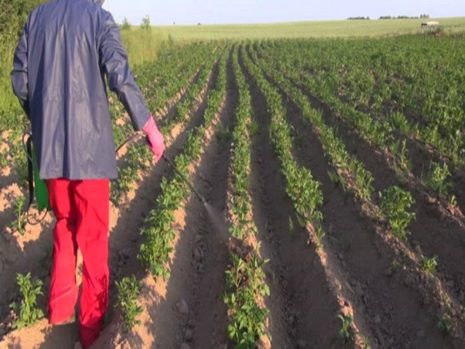
Senication with superphosphate
Using superphosphate as a chemical agent, you must first prepare the solution.To do this, 2 kg of double phosphate is diluted with 10 liters of water and insisted throughout the day, stirring occasionally. When the solution has settled a little, the light part of the product is drained and used to spray potato tops at the rate of 2 liters per 100 sq. m.
In addition, for each liter of water, 0.1 g of herbicide should be added, which initiates the process of leaving carbohydrates and nitrogenous substances from the leaves, contributes to the saturation of tubers with them. The superphosphate mixture must be prepared a day before use. During this period, all the granules will have time to dissolve and the resulting solution will receive a sufficient amount of active components.
Subject to the correct procedure, favorable climatic conditions and soil conditions, senication can lead to the complete death of the tops. This will eliminate the need to manually harvest it before harvesting root crops.

Other treatments
With the exception of superphosphate, for chemical spraying of tops, you can use a complex fertilizer, which contains ammonium polyphosphate. Before use, a herbicide with a concentration of 0.01% must be added to the fertilizer. One hundred square meters of land will require 30 liters of liquid fertilizer and 10 g of herbicide.
In order to increase the yield of young potatoes, it is recommended to use a more complex solution, including superphosphate, potassium sulfate and ammonium nitrate. Each component is required at a concentration of 2–5%. The total consumption of the working solution will be 10 liters per 60–75 meters. Processing with this solution is also carried out during the flowering period.

To increase the amount of potassium and beneficial nutrients in tubers, plants can be treated with ash. The beds with potatoes should be covered with a dense layer one and a half weeks after the beginning of the flowering phase. During the ripening period of root crops, you can spray the ground parts of the crop with a concentrated solution of humate, which is used as foliar feeding of seedlings.
Desiccation: description of the reception
When caring for the beds, experienced gardeners carry out, in addition to the senication, chemical treatment, which leads to the drying of the tops. The principle of action is to change the processes of metabolism and photosynthesis in stems and leaves. This makes the ripening more even and improves the biochemical content of substances in the crop.
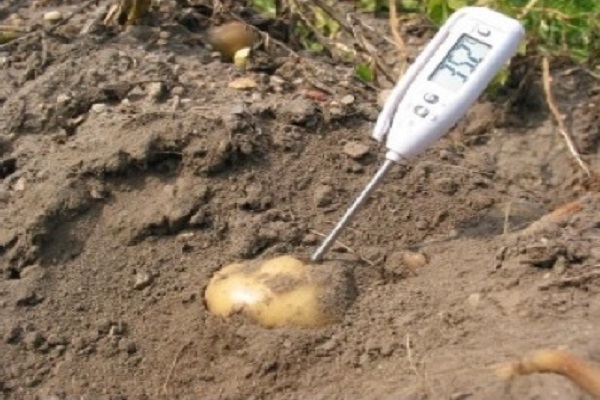
When is treatment applied?
Desiccation of plants is required when the crop is severely affected by late blight during cultivation. The result of spraying will be noticeable in 10-14 days - the tops will begin to dry out and crumble. It is also possible to apply agricultural practice in cases where the tops are not infected with the disease, but its abundance complicates the harvest. It is also necessary to treat the crop with desiccants if the root crops are grown in wet, cool weather and with uneven ripening of crops.
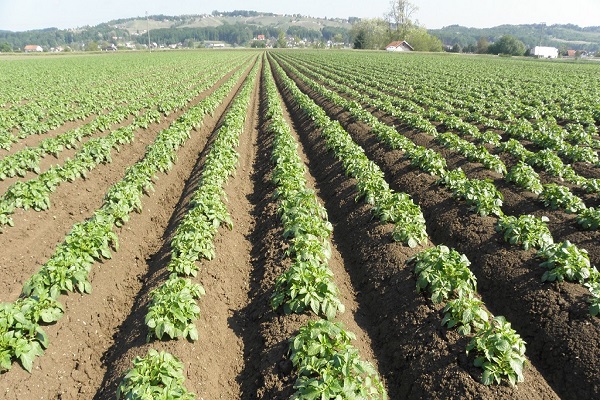
How is desiccation carried out?
To carry out desiccation, it is enough to draw the agent into the sprayer and treat the entire surface of the tops. The work on processing the tops begins a week before harvesting on food crops and 10-12 days on seed varieties of potatoes... When processing, it is important to observe the uniformity of the spray so that the entire tops are covered with a proportionate amount of the preparation.

Desiccants
Common desiccants include magnesium chlorate with a concentration of 60% for ware potatoes (application rate per hectare - 25-30 kg), a solution of Reglon with a concentration of 20% for seed planting (application rate - 2 liters per hectare). Also suitable for desiccation is the universal Harveyd 25 F preparation, suitable for all types of potatoes. You will need about 3 kg of Harveyd per hectare of land.
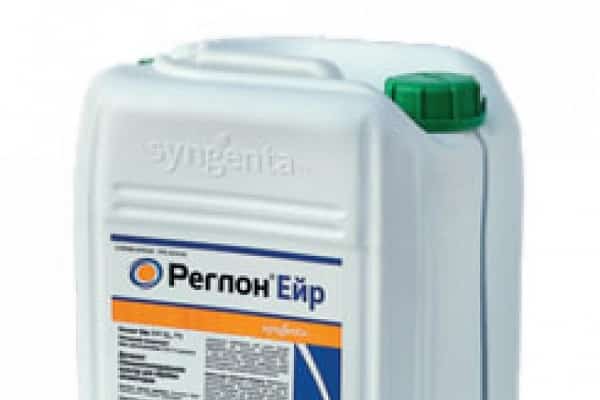
Removing the tops
Pre-harvest haulm removal using non-toxic chemicals is an important agricultural technique required on any size of land. Mowing withered tops helps to ennoble the soil, accelerate the ripening of root crops, improve the quality of the crop, and dry the beds for the next plantings. It is possible to remove vegetation even before treatment with a chemical solution in the presence of tall stems.
Getting rid of excess foliage mass ensures good absorption of the herbicide and prevents leaf regrowth.
If the removal of tops occurs after desiccation, then the green vegetation will also be destroyed and its dry remains will need to be removed after a week. This is most important when there are thick stalks that obstruct the potato harvesting technique. Timely removal of the tops accelerates the growth of the peel on root crops and allows you to get saturated with the maximum possible amount of vitamins and nutritional components.

When removing potato tops, it is important to follow the list of rules:
- It is impossible to mow and remove vegetation earlier than a week before harvesting, as long-term presence of tubers in the soil without outer tops can lead to infection with dangerous diseases. And a later agricultural practice, on the contrary, will not allow the peel of root crops to grow strong enough.
- If the tops were infected with late blight before processing, then they must be burned in order to prevent the spread of the disease.
- The procedure can be performed in two successive stages - first, cut off only the upper part of the tops with the bulk of the leaves, and after a week, carry out a further cut.
- It is not recommended to completely remove the stems and cut them to soil level, as this will interfere with visually finding the location of the fruit nests of root crops. The optimal size of the cut stems is about 20-25 cm.
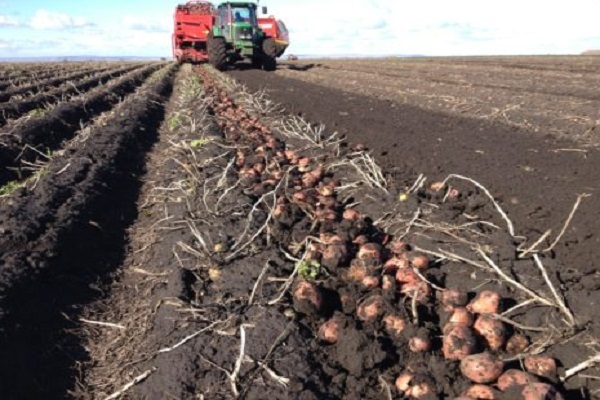
For harvesting vegetation, you can use both manual methods and specialized equipment. Topping machines equipped with cutting blades help speed up the process. The technique cuts the tops, chops and directs them to the inner compartment. To facilitate the workflow, you can combine both methods and alternate the techniques, depending on the current state of the soil and vegetation.

